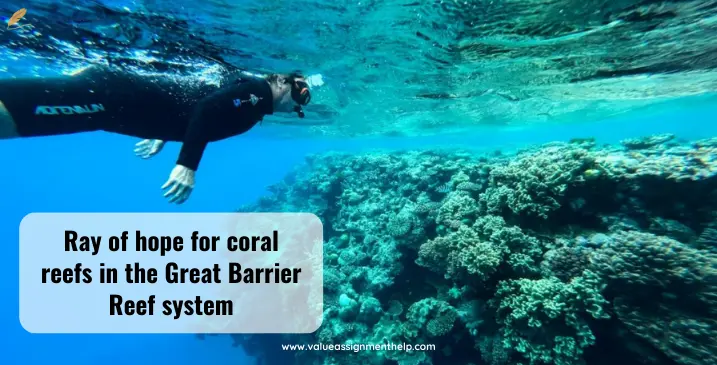
Search Assignments
Our Experts

Search Assignments

Customers Reviews
Recently, we came across the news of a successful trial of freezing larvae of corals in the Great Barrier Reef in Australia. Scientists have successfully conducted the first trial stage and are optimistic about preserving the barrier reef system in Australia and globally.
The trail is one of its kind and has been undertaken for the first time at the Australian Institute of Marine Sciences. The trial in its first stage is marked successful, and its successive trials are soon to follow.

According to scientists, “cyromesh” technology is the bone of the experiment, which is affordable, more sensitive, and effective. Earlier means of storing the larvae were expensive and employed technology such as Lasers. With Cyromesh, larvae can be stored at temperatures as low as -196 degrees Celsius.
The technology was, however, first tested on large and small Hawaiian Corals and trials on larger species failed. PhD student Nikolas Zuchowicz first tested the technology.
What is noteworthy is that in December, the same technology was tested on Corals in the Great Barrier Reef system in Australia and was remarkably successful. “In successive trials, the technology is a game-changer in preserving coral reefs worldwide. This affordable solution is a major determinant in the future of corals”, said Mary Hagedorn, a senior research scientist at Smithsonian National Zoo and Conservation Biology institute.
Freezing of larvae of coral species is crucial because it assures the preservation of endangered species of corals. The trial has been undertaken with the joint collaboration of AIMS (Australian Institute of Marine Sciences), the Smithsonian National Zoo and Conservation Biology Institute, the Great Barrier Reef Foundation and the Taronga Conservation Society Australia as part of the Reef Restoration and Adaptation Programme.
Australia has the world's most extensive reef system, and a major portion of the Australian economy derives from it. So BE it in food, medicine, marine industry or tourism. Globally, other coral reef systems in Cuba and America are also vital.
It also plays a predominant role in sustaining the balance of humans and marine life.
Coral reefs are fed by algae living on their body. These algae are also responsible for the bright colours of the corals. However, in the case of rising temperatures, corals expel these algae to remain cool and prolonged separation might also lead to the death of corals due to starvation.
In the past decade, corals reefs have faced a major threat of extinction posed by deteriorating climatic conditions, especially in the last seven years because it has faced four bleaching events as a result of escalating global temperatures, one of which was “first-time-ever “during La Nina Phenomenon, which is responsible for bringing cooler temperatures.
As a result, frequent bleaching events don’t provide corals sufficient time to replenish, which explains their decreasing numbers in low-water oceans.
The major question that might be striking in your head might be that it is enough to protect 2300 km long biodiversity that is not only the source of livelihood for over half a billion people but also a significant contributor to sustaining marine life biodiversity in the oceans.
Well, the answer is somewhat clear. The technology is a groundbreaking discovery in preserving marine biodiversity. However, it is not enough. Preservation and releasing them will pose the same threat in the future, with graver impacts. For example, suppose the global temperatures rise as per predicted data. In that case, all the efforts will go in vain and coral species will not be able to sustain themselves since the rising temperature is the reason for their deterioration in the first place.
As per United Nations, global temperatures will rise by 2.5 degree Celsius by the end of the century, which is higher than the maximum 2-degree cap that humanity can sustain.
Success in freezing the larvae will allow scientists to restore them in the coming future. However, the freezing of Larvae is just attaining the first milestone. The trial has marked success on a smaller section of biodiversity, and its trial on larger varieties is yet to prove fruitful.
In 2017, MOW research indicated that more than 70 million trips are associated with coral reefs, which for the marine tourism industry translates to 26% growth in the “blue economy” by the end of 2030. In numbers, that is more than 37 Billion dollars in business fueled by coral reefs.
However, reefs not only provide scenic views for travellers from around the world but also prevents the coastlines from erosion and sea storms that can damage the very base of the marine life support system.
Nonetheless, continuous and sustained experiments are the only way to fulfil the promises of meeting climatic goals.
(VAH helps with homework to provide you with the scope to secure better grades for your assignments)




No Comments